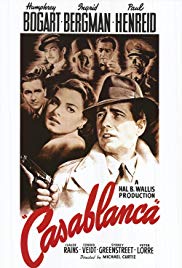Using Casablanca to Teach the Hero’s Journey
This film is a simple story of redemption through sacrifice. Rick has lost his way, consumed by bitterness and longing. When he finds that he can have what he has so long desired, he gives it all up for a cause and, in so doing, finds his way again. However, when the story is analyzed from the standpoint of the Hero’s Journey, first identified by Joseph Campbell, it clearly contains most of the twelve stages identified in the film by Christopher Vogler in his book, The Writer’s Journey: Mythic Structure for Writers, 3rd Edition. Note, however, as is often the case, the stages do not appear in their classic order. Casablanca is not the strongest example of the Monomyth, but the fact that the stages of the Hero’s Journey can be found in such a simple story of love and redemption, speaks to the power of the concept. (Click here for a student handout describing the stages of the journey most often used film.) TWM has also provided a worksheet which can be used by students to track the stages of the journey. See TWM’s Hero’s Journey Film Study Worksheet.
Set out below are the suggested strong responses to the prompts on the Hero’s Journey Film Study Worksheet. The suggested responses are matters of interpretation and reasonable minds may differ. Student responses are not right or wrong, they are weak or strong.
I. Write a short single-paragraph description of the Hero’s Journey described in Casablanca.
Suggested Response:
Rick progresses from a self-centered cynic (“I stick my neck out for nobody” and “The problems of the world are not in my department”), to a caring individual who is able to sacrifice a life with the woman he loves for the benefit of others and who joins the fight of good men against fascism.
II. For each stage of the Hero’s Journey describe the action of the film, if any, which manifests the stage. Specify the attributes of the stage to which these actions relate. Remember, some characters can have more than one function in the story and one or more of the stages can be skipped or combined.
SECTION ONE — Introduction to Setting, Characters & Conflict
1. The Ordinary World:
Suggested Response:
Rick’s café in Morocco is Rick’s ordinary world, a world in which Rick is disengaged and cynical. He lives without love or allegiance to a cause at a time when people had to a take stand against fascist tyranny. It could also be argued that the flashback scene showing Rick in Paris prior to the German occupation constitutes his ordinary world. Rick’s time in Paris shows a happy man not yet in the pit of disillusion. Either of the options work and both the happiness and the disillusion are important characteristics of Rick.
2. Call to Adventure:
Suggested Response:
The call to adventure can be found when Laszlo asks Rick for the letters of transit. It could also be said that the call to adventure occurred when Ilsa walks into Rick’s café. Prior to this moment, Rick lived with a good degree of harmony in the turmoil around him.
3. Refusal of the Call:
Suggested Response:
Rick refuses the call when he tells Laszlo that the letters of transit are not for sale. Another refusal occurs at the beginning of the late night interview with Ilsa.
4. Meeting with the Mentor:
Suggested Response:
Laszlo is Rick’s mentor. Laszlo is a true leader, inspiring people to go beyond what they had ever thought possible in doing what is right. Laszlo is the only person in the movie that Rick admires. It could be said that Laszlo mentors Rick just by existing in close proximity. Laszlo’s active mentoring of Rick occurs just after Rick undertakes the quest by telling Ilsa that he will think for them both. Although Rick has already crossed the first threshold when Rick tells his orchestra to play “La Marseillaise” neither Rick nor the audience know if he is going to follow through on this small movement toward anti-fascism. The active mentoring occurs in the scene when Laszlo and Carl have just come into the bar, running from the police who have broken up the Underground meeting. As Rick tends to the small cut on Laszlo’s hand, Rick makes a particularly cynical remark and Laszlo responds, “You know how you sound, Monsieur Blaine? Like a man who’s trying to convince himself of something he doesn’t believe in his heart. Each of us has a destiny, for good or for evil. . . . I wonder if you know that you’re trying to escape from yourself and that you’ll never succeed.” Laszlo has Rick figured out.
5. Crossing the First Threshold:
Suggested Response:
When Rick gives the o.k. to the orchestra to play “La Marseillaise” he was crossing the first threshold. At that time “La Marseillaise,” the French national anthem, was a song that for the last 150 years had been associated with resistance to tyranny. Thus, it had a meaning for Laszlo, a Czech, and for all of the refugees in Rick’s saloon of whatever nationality. The song is recognized by the Germans and everyone present as an act of resistance and leads the Germans to demand that Renault to close the café.
SECTION TWO — Action, Climax, Triumph
6. Tests, Allies, Enemies:
Suggested Response:
Rick’s quest begins before he really knows that he is on the quest. It could be argued that it started when he began doing things like helping the young Bulgarian couple get the money to escape, but he had done similar things in the past. It could also be argued that it started when he tolerated his employees being in the Underground. According to this argument, his allies are his employees. However, a strong argument is that these types of events had occurred before the call to adventure and that they were part of Rick’s Ordinary World. This argument continues that the quest didn’t really begin until Ilsa and Laszlo came to his club. Rick’s enemies are General Strasser and for a time, the Prefect of Police Captain Renault. The conscious quest that begins when Rick agrees to start thinking for both himself and Ilsa doesn’t involve any allies, he pulls it off pretty much by himself without the assistance of anyone, except perhaps Renault at the very end. There are several tests, as when he pulls the gun on Renault, kills Strasser and lies to Laszlo about what happened the night before with him and Ilsa. At the airport, Renault becomes an ally. Laszlo and Ilsa become allies.
7. Approach to the Inmost Cave:
Suggested Response:
An argument could be made that this stage occurs when Ilsa comes to Rick’s room and asks him for the letters of transit. When he refuses she threatens him with a gun. He says to her: “Go ahead and shoot. You’ll be doing me a favor.” But that’s not really Rick’s approach to the inmost cave because he has not yet fully accepted the quest and the possibility of death from the quest. This stage occurs off-camera, when Rick decides on his plan to force Renault to allow Ilsa and Laszlo to get on the Lisbon plane. This plan had many risks and could easily have resulted in Rick, Ilsa and Laszlo being killed or put into a concentration camp. A good argument could be made that this stage is missing from Rick’s quest.
8. Ordeal:
Suggested Response:
This stage involves Rick’s having to think for Ilsa and creating and executing the plan to get Ilsa and Laszlo out of Casablanca.
9. Reward:
Suggested Response:
Rick’s reward occurs when the plane to Lisbon takes off with Laszlo and Ilsa on it. Another valid response is that Rick receives his reward when Laszlo, his mentor, says, “Welcome back to the fight. This time I know our side will win.” Yet a third valid response is that Rick’s reward is something that he gives to himself, the self-respect that he now has that he has done the right thing and the love that he can allow himself to feel for Ilsa, knowing that she loves him, too. A final possible reward is Ilsa’s love, which he will always have, from afar, and which he would eventually have lost if he had not helped Laszlo escape with his wife, i.e., with Ilsa.
SECTION THREE — Resolution and Denouement
10. The Road Back:
Suggested Response:
This stage occurs at the very end when Rick and Renault are setting off to find the Underground.
11. Resurrection:
Suggested Response:
Rick’s resurrection occurs throughout the last quarter of the film, as he begins to think for both himself and Ilsa, determines that their love is ill-fated and that he will help Laszlo take Ilsa to Lisbon and then to the U.S.
12. Return with the Elixir:
Suggested Response:
The elixir in this film is Rick’s realization that there is something outside of himself worth fighting for. Earlier he had said he was not good at being noble, but he is now behaving as would a noble individual. The return is the audience’s realization of this fact.
III. Identify the archetypes of the Hero’s Journey that appear in the movie and, for each, describe the function it performs in telling the film’s story. The following are the archetypes associated with the story of a quest.
1. The Hero:
Suggested Response:
Rick is the hero and the protagonist of the story.
2. The Mentor:
Suggested Response:
Laszlo is the mentor. See the description of Laszlo’s role in stage 4.
3. Threshold Guardians:
Suggested Response:
Renault in his incarnation early in the movie is a threshold guardian. Later, he changes to become an ally.
4. The Herald:
Suggested Response:
Laszlo is the Herald, as well as the Mentor.
5. Shapeshifter:
Suggested Response:
Rick is the main shapeshifter in this story. Ilsa, too, is a shapeshifter, being Rick’s passionate lover in Paris one minute and gone the next, then appearing as the devoted wife of Laszlo and finally being willing to throw it all over and go with Rick.
6. The Shadow:
Suggested Response:
It is the other side of Rick, the bitter disillusioned side that is the Shadow. As the movie begins we see Rick in the shadow and as the movie progresses, he moves out of it.
7. The Trickster:
Suggested Response:
There is no trickster in this story.
IV. Describe any other archetypes that appear in the story and the functions they perform:
There are no other archetypes in this story.
After the film has been viewed give students time to share ideas with others and to fill in their worksheets. Give and take of ideas among students can be illuminating in this effort to determine whether or not Rick constitutes a true hero.
Assignment: Deliver the following prompt:
In a formal essay, illustrate, using as many of the stages of the Hero’s Journey as you see appropriate to support your point, how Rick, in Casablanca becomes a heroic character. Be sure to show his transformation from cynic to believer. Be sure to site support by referring directly to specific scenes, dialogue or action taken.
Evaluate the essay using the rubrics to which your students have grown accustomed.





